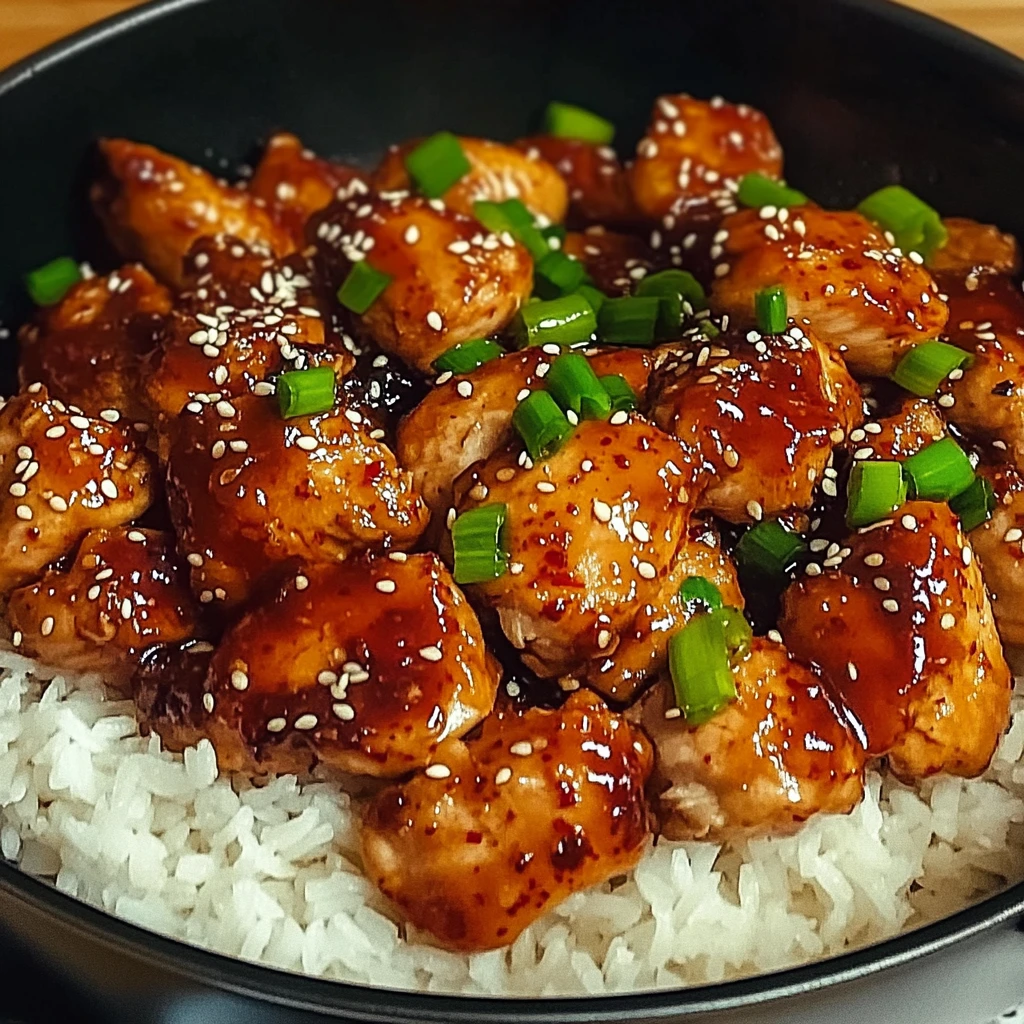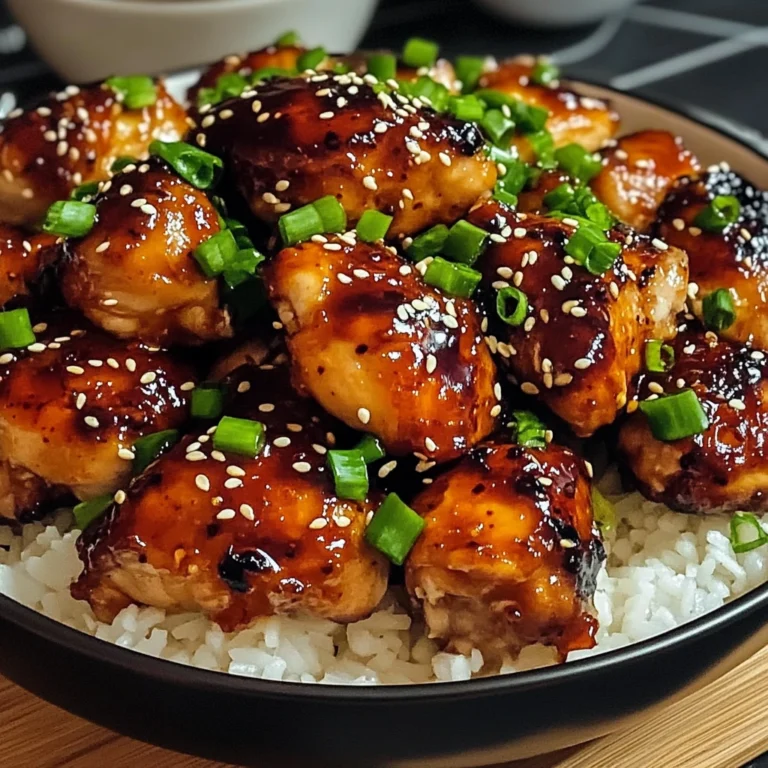Korean cuisine has taken the world by storm, and one of the most beloved dishes is the mouthwatering Korean Gochujang Chicken. This vibrant, spicy-sweet chicken dish is a fusion of traditional Korean flavors that will tantalize your taste buds and leave you craving more. With its unique blend of gochujang (Korean chili paste), honey, and savory soy sauce, this recipe is a must-try for any fan of bold, dynamic flavors.
Table of Contents
Discovering the Magic of Gochujang
At the heart of Korean Gochujang Chicken is the star ingredient – gochujang. This Korean chili paste is a staple in many traditional dishes, adding a delightful combination of heat, sweetness, and umami flavor. Gochujang is made from fermented red chili peppers, glutinous rice, soybeans, and salt, resulting in a complex, slightly spicy, and subtly sweet condiment that brings life to any dish.
Ingredient Breakdown: The Perfect Harmony of Flavors
- Chicken: The versatile protein in this dish, chicken thighs or breasts are both excellent choices. Chicken thighs offer a richer, juicier texture, while breasts provide a leaner option.
- Gochujang: This Korean chili paste is the star of the show, providing the signature spicy-sweet flavor profile.
- Honey: A natural sweetener that balances the heat of the gochujang and adds depth to the marinade.
- Soy Sauce: Providing a savory, umami element to the dish, soy sauce helps to round out the flavors.
- Sesame Oil: Adding a nutty, aromatic note, sesame oil enhances the overall flavor profile.
- Garlic and Ginger: These aromatic ingredients lend their distinctive flavors and aroma to the dish.
- Vegetables: Onions and bell peppers add a wonderful crunch and color to the stir-fry.
- Garnishes: Chopped green onions and sesame seeds provide a flavorful and visually appealing finishing touch.
Step-by-Step Guide to Delicious Korean Gochujang Chicken
Preparing Korean Gochujang Chicken is a straightforward process that yields remarkable results. Let’s walk through the steps:
Marinate the Chicken
In a bowl, combine the gochujang, honey, soy sauce, sesame oil, garlic, and ginger. Add the chicken pieces and stir well to ensure the marinade evenly coats the meat. Allow the chicken to marinate for at least 10 minutes, or up to 2 hours for deeper flavor.
Cook the Chicken and Vegetables
Heat vegetable oil in a large skillet or wok over medium-high heat. Add the sliced onions and bell peppers, sautéing for 3-4 minutes until softened. Remove the vegetables from the pan and set them aside.
In the same skillet, add the marinated chicken pieces. Cook for 5-7 minutes, stirring occasionally, until the chicken is browned and cooked through.
Finish the Dish
Once the chicken is nearly done, return the sautéed vegetables to the skillet. Allow everything to cook together for an additional 2-3 minutes, letting the chicken soak up the flavors of the vegetables.
To finish, sprinkle the dish with chopped green onions and sesame seeds, adding a vibrant touch and delightful crunch.
Flavor Variations and Customizations
The beauty of Korean Gochujang Chicken lies in its versatility. Here are some ways to customize the dish to suit your preferences:
- Protein Variations: Experiment with different proteins, such as tofu, shrimp, or even beef, for a unique twist on the classic dish.
- Vegetable Additions: Incorporate other vegetables like broccoli, carrots, or zucchini to add more color and nutrition.
- Spice Level Adjustments: Adjust the amount of gochujang used to control the heat level, making it as mild or as spicy as you desire.
- Sauce Variations: Try incorporating other sauces, like teriyaki or hoisin, for a different flavor profile.
- Vegan/Vegetarian Options: Use plant-based proteins like tofu or seitan to create a delicious meatless version of the dish.

Pairing Suggestions for Korean Gochujang Chicken
To complement the bold flavors of Korean Gochujang Chicken, consider serving it with:
- Steamed Rice: The neutral flavor of rice provides the perfect canvas for the spicy-sweet chicken.
- Korean Pickles: Crisp, tangy Korean pickles, such as kimchi or oi sobagi, make an excellent side dish.
- Korean Beverages: Pair the dish with a refreshing Korean beer, soju (Korean rice wine), or traditional Korean tea.
- Other Korean Dishes: Enjoy Korean Gochujang Chicken as part of a larger Korean meal, such as Korean BBQ, bibimbap, or japchae.
Nutritional Information and Health Benefits
In addition to its mouthwatering flavors, Korean Gochujang Chicken offers some notable health benefits:
- Lean Protein: Chicken is a lean, high-quality protein source, providing essential amino acids to support muscle health.
- Gochujang Benefits: Gochujang is believed to have the potential to boost metabolism and aid in weight management.
- Antioxidant Properties: Garlic and ginger, two key ingredients, are renowned for their antioxidant properties, which can support overall well-being.
To make the dish even healthier, you can opt for lower-sugar honey or use less gochujang to reduce the overall spice level. Additionally, grilling or baking the chicken instead of frying can make the dish more nutritious.
Frequently Asked Questions
How can I adjust the sweetness in Korean Gochujang Chicken if I find it too sweet?
If you find the dish too sweet, you can adjust the sweetness by reducing the amount of honey or sugar used in the marinade. Alternatively, you can add a little more gochujang to balance out the sweetness with its spiciness. Another option is to incorporate a bit of vinegar or citrus juice (like lime or lemon) to introduce acidity, which can help counterbalance the sweetness without altering the overall flavor profile too much.
What type of chicken is best for making Korean Gochujang Chicken?
The best type of chicken for Korean Gochujang Chicken is typically bone-in, skin-on chicken thighs due to their richer flavor and juiciness. However, boneless chicken thighs work well for quicker cooking. You can also use chicken breasts if you prefer a leaner option, but be careful not to overcook them as they can become dry. For a unique twist, consider using chicken wings, which can offer a delightful crispy texture when cooked properly.
Can I use gochujang in other chicken recipes besides Gochujang Chicken?
Absolutely! Gochujang is a versatile ingredient that can enhance various chicken recipes. You can use it in marinades for grilled or roasted chicken, as a flavor base for stir-fries, or mixed into sauces for chicken tacos or wraps. It can also be incorporated into soups or stews for a spicy kick. Experimenting with gochujang can add a delicious Korean twist to many chicken dishes.
What are some common mistakes to avoid when making Korean Gochujang Chicken?
Some common mistakes to avoid include not marinating the chicken long enough, which can result in less flavor penetration. Another mistake is using too high a heat when cooking, which can cause the chicken to burn on the outside while remaining undercooked inside. Additionally, neglecting to balance flavors—such as sweetness, spiciness, and umami—can lead to a dish that feels one-dimensional. Lastly, not allowing the sauce to thicken properly can result in a watery dish, so make sure to simmer it adequately after adding the chicken back to the pan.
More Related Recipes You Might Enjoy
Get ready to embark on a flavorful journey with Korean Gochujang Chicken! This vibrant dish is sure to become a new favorite, delivering a harmonious balance of spice, sweetness, and savory delight. Experiment with different variations and enjoy exploring the rich tapestry of Korean cuisine.
Looking for more visual inspiration? Follow me on Pinterest, where I share new recipes, dinner tips, and behind-the-scenes kitchen moments every week. Buon appetito!

Savor the Flavor: Easy Korean Gochujang Chicken Recipe for Everyone
- Total Time: 25 minutes
- Yield: 4 servings 1x
Description
Korean Gochujang Chicken is a vibrant, spicy-sweet chicken dish that combines traditional Korean flavors with gochujang, honey, and soy sauce.
Ingredients
- 1 pound chicken thighs or breasts
- 1/4 cup gochujang
- 2 tablespoon honey
- 1/4 cup soy sauce
- 2 tablespoon sesame oil
- 3 cloves garlic, minced
- 1 tablespoon ginger, minced
- 1 cup sliced onions
- 1 cup sliced bell peppers
- 2 tablespoon vegetable oil
- 2 green onions, chopped
- 1 tablespoon sesame seeds
Instructions
1. In a bowl, combine the gochujang, honey, soy sauce, sesame oil, garlic, and ginger. Add the chicken pieces and stir well to ensure the marinade evenly coats the meat. Allow the chicken to marinate for at least 10 minutes, or up to 2 hours for deeper flavor.
2. Heat vegetable oil in a large skillet or wok over medium-high heat. Add the sliced onions and bell peppers, sautéing for 3-4 minutes until softened. Remove the vegetables from the pan and set them aside.
3. In the same skillet, add the marinated chicken pieces. Cook for 5-7 minutes, stirring occasionally, until the chicken is browned and cooked through.
4. Once the chicken is nearly done, return the sautéed vegetables to the skillet. Allow everything to cook together for an additional 2-3 minutes, letting the chicken soak up the flavors of the vegetables.
5. To finish, sprinkle the dish with chopped green onions and sesame seeds.
Notes
This dish can be served with steamed rice or Korean pickles for a complete meal.
- Prep Time: 10 minutes
- Cook Time: 15 minutes
- Category: Main Dish
- Method: Stir-fry
- Cuisine: Korean
Nutrition
- Serving Size: 1 serving
- Calories: 350
- Sugar: 8g
- Sodium: 800mg
- Fat: 15g
- Saturated Fat: 3g
- Unsaturated Fat: 10g
- Trans Fat: 0g
- Carbohydrates: 20g
- Fiber: 2g
- Protein: 30g
- Cholesterol: 80mg

